Racial, ethnic disparities persist for COVID-19 hospitalizations, ED visits
Racial and ethnic disparities for hospitalizations and ED visits related to COVID-19 persisted through the end of last year, according to two new MMWR reports.
An analysis performed by Sebastian D. Romano, MPH, an associate service fellow at the CDC, and colleagues found that the proportion of COVID-19 hospitalizations has been highest among Hispanic or Latino patients, and that racial and ethnic disparities for COVID-19 hospitalizations — although more pronounced early in the pandemic — persisted to through December.

A second study of more than 200,000 COVID-19-related ED visits between October and December found that — compared with white people — Hispanic and American Indian or Alaskan Native persons were 1.7 times more likely to visit the ED for COVID-19, and Black people were 1.4 times more likely, according to CDC Epidemic Intelligence Service officer Amanda R. Smith, PhD, MPH, and colleagues.

“This information and the ongoing surveillance data we see daily from states across the country underscore the critical need — and an important opportunity — to address health equity as a core element in all of our public health efforts,” CDC Director Rochelle P. Walensky, MD, MPH, said Monday during a White House press briefing. “These disparities were not caused by the pandemic — but they were certainly exacerbated by it.”
Romano and colleagues used a database of more than 3.7 million hospital discharges, including around 300,000 patients hospitalized with COVID-19, to examine trends in the proportion of hospitalized patients with COVID-19 across different racial groups between March and December 2020.
They found that the cumulative adjusted proportionate hospitalization ratios (aPHRs) across all four United States Census regions were highest among Hispanic or Latino patients, with a ratio range of 2.7 to 3.9. These disparities were highest between May and July 2020, with the highest monthly aPHRs among Hispanics or Latino patients, reaching more than 9 in the West and Midwest, more than 6 in the South and more than 3 in the Northeast.
“Identification of specific social determinants of health that contribute to geographic and temporal differences in racial and ethnic disparities at the local level can help guide tailored public health prevention strategies and equitable allocation of resources, including COVID-19 vaccination, to address COVID-19-related health disparities and can inform approaches to achieve greater health equity during future public health threats,” Roman and colleagues wrote.
Smith and colleagues analyzed 282,220 COVID-19-related ED visits from 13 states using data from the National Syndromic Surveillance Program. They found that, compared with white individuals, Hispanic, American Indian or Alaskan Native, and Black people had a rate ratio for COVID-19-related ED visits of 1.39 to 1.77.
“It is important to prioritize prevention resources, management of underlying health conditions, safe school and work conditions, flexible leave policies, and enhanced access to and acceptability of SARS-CoV-2 testing and COVID-19 vaccination services to reach disproportionately affected racial/ethnic groups and reduce the need for emergency care for COVID-19,” Smith and colleagues wrote. “Efforts such as these are critical to address the drivers of racial/ethnic disparities.”
References:
Romano SD, et al. MMWR Morbid Mortal Wkly Rep. 2021;doi:10.15585/mmwr.mmmm7015e2.
Smith AR, et al. MMWR Morbid Mortal Wkly Rep. 2021;doi:10.15585/mmwr.mm7015e3.

